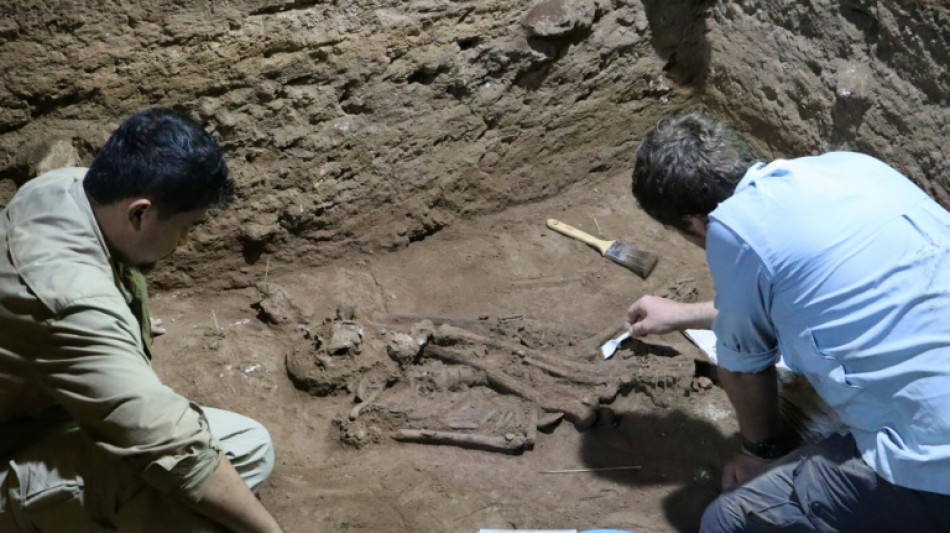
-
 Monumental art displayed in shade of Egypt's pyramids
Monumental art displayed in shade of Egypt's pyramids
-
Stocks mixed as tech titans struggle

-
 California governor Newsom slams Trump at COP30
California governor Newsom slams Trump at COP30
-
Alcaraz fights back to beat Fritz at ATP Finals

-
 Russia offers US nuclear talks in bid to ease tensions
Russia offers US nuclear talks in bid to ease tensions
-
Turkey seeks more than 2,000 years behind bars for Erdogan rival

-
 UK court jails Chinese bitcoin fraudster for over 11 years
UK court jails Chinese bitcoin fraudster for over 11 years
-
Fanfare as Guinea launches enormous Simandou iron ore mine
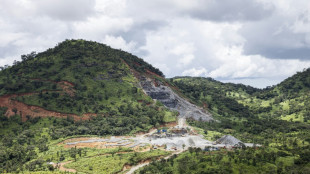
-
 Iraqis vote in general election at crucial regional moment
Iraqis vote in general election at crucial regional moment
-
Shock follows carnage after suicide bombing in Islamabad

-
 Ford returns to pull England strings against All Blacks
Ford returns to pull England strings against All Blacks
-
Stocks mixed as end to US shutdown appears closer

-
 BBC must 'fight' for its journalism, outgoing chief says amid Trump lawsuit threat
BBC must 'fight' for its journalism, outgoing chief says amid Trump lawsuit threat
-
Atalanta turn to Palladino after Juric sacking

-
 'Sayyid says': Influential Shiite cleric's supporters boycott Iraq vote
'Sayyid says': Influential Shiite cleric's supporters boycott Iraq vote
-
'It's un-British': lawmakers raise concerns about aquarium penguins

-
 Prosecutor files 142 charges against Istanbul mayor, a top Erdogan critic
Prosecutor files 142 charges against Istanbul mayor, a top Erdogan critic
-
Agha hundred lifts Pakistan to 299-5 in 1st Sri Lanka ODI

-
 German court rules against OpenAI in copyright case
German court rules against OpenAI in copyright case
-
Calls for 'mano dura' as crime-rattled Chile votes for president

-
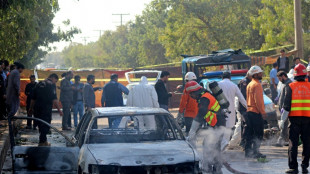 Pakistani Taliban claim deadly suicide attack in Islamabad
Pakistani Taliban claim deadly suicide attack in Islamabad
-
BBC grapples with response to Trump legal threat

-
 Cristiano Ronaldo says 2026 World Cup 'definitely' his last
Cristiano Ronaldo says 2026 World Cup 'definitely' his last
-
Trump says 'we've had a lot of problems' with France

-
 Stocks mostly rise as end to US shutdown appears closer
Stocks mostly rise as end to US shutdown appears closer
-
'Splinternets' threat to be avoided, says web address controller

-
 Yamal released from World Cup qualifiers by 'upset' Spanish federation
Yamal released from World Cup qualifiers by 'upset' Spanish federation
-
China's 'Singles Day' shopping fest loses its shine for weary consumers
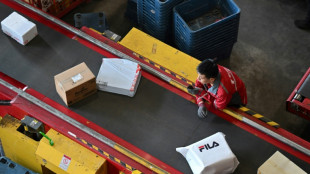
-
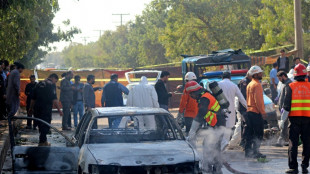 Suicide bombing in Islamabad kills 12, wounds 27
Suicide bombing in Islamabad kills 12, wounds 27
-
Philippines digs out from Typhoon Fung-wong as death toll climbs

-
 Iraqis vote in general election at a crucial regional moment
Iraqis vote in general election at a crucial regional moment
-
Asian stocks wobble as US shutdown rally loses steam

-
 UK unemployment jumps to 5% before key govt budget
UK unemployment jumps to 5% before key govt budget
-
Japanese 'Ran' actor Tatsuya Nakadai dies at 92

-
 AI stock boom delivers bumper quarter for Japan's SoftBank
AI stock boom delivers bumper quarter for Japan's SoftBank
-
Asian stocks struggle as US shutdown rally loses steam

-
 India probes deadly Delhi blast, vows those responsible will face justice
India probes deadly Delhi blast, vows those responsible will face justice
-
Pistons win streak hits seven on night of NBA thrillers

-
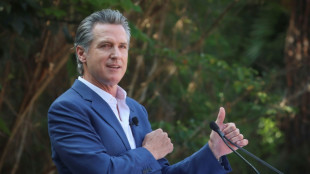 US state leaders take stage at UN climate summit -- without Trump
US state leaders take stage at UN climate summit -- without Trump
-
Burger King to enter China joint venture, plans to double stores

-
 Iraqis vote in general election in rare moment of calm
Iraqis vote in general election in rare moment of calm
-
Philippines digs out from Typhoon Fung-wong as death toll climbs to 18

-
 'Demon Slayer' helps Sony hike profit forecasts
'Demon Slayer' helps Sony hike profit forecasts
-
Who can qualify for 2026 World Cup in next round of European qualifiers

-
 Ireland's climate battle is being fought in its fields
Ireland's climate battle is being fought in its fields
-
Sony hikes profit forecasts on strong gaming, anime sales

-
 End to US government shutdown in sight as stopgap bill advances to House
End to US government shutdown in sight as stopgap bill advances to House
-
'Western tech dominance fading' at Lisbon's Web Summit

-
 Asian stocks rise as record US shutdown nears end
Asian stocks rise as record US shutdown nears end
-
'Joy to beloved motherland': N.Korea football glory fuels propaganda


Ancient skeleton reveals amputation surgery 31,000 years ago
A skeleton discovered in a remote corner of Borneo rewrites the history of ancient medicine and proves amputation surgery was successfully carried out about 31,000 years ago, scientists said Wednesday.
Previously, the earliest known amputation involved a 7,000-year-old skeleton found in France, and experts believed such operations only emerged in settled agricultural societies.
The finding also suggests that Stone Age hunter-gatherers living in what is now Indonesia's East Kalimantan province had sophisticated medical knowledge of anatomy and wound treatment.
"It rewrites our understanding of the development of this medical knowledge," said Tim Maloney, a research fellow at Australia's Griffith University, who led the work.
The skeleton was uncovered in 2020 in the imposing Liang Tebo cave known for its wall paintings dating back 40,000 years.
Surrounded by bats, terns and swiftlets, and interrupted by the occasional scorpion, scientists painstakingly removed sediment to reveal an astoundingly well-preserved skeleton.
It was missing just one notable feature: its left ankle and foot.
The base of the remaining leg bone had a surprising shape, with knobbly regrowth over an apparently clean break, strongly indicating that the ankle and foot were removed deliberately.
"It's very neat and oblique, you can actually see the surface and shape of the incision through the bone," Maloney told a press briefing.
Other explanations, like an animal attack, crushing injury, or fall, would have created bone fractures and healing different from those seen in the skeleton's leg.
A tooth and surrounding sediment showed the skeleton is at least 31,000 years old and belongs to a person who died at around 20 years old.
Despite the incredible trauma of amputation, they appear to have survived six to nine years after the operation, based on the regrowth on the leg bone, and suffered no major post-operative infection.
That suggests "detailed knowledge of limb anatomy and muscular and vascular systems," the research team wrote in a paper published Wednesday in the journal Nature.
"Intensive post-operative nursing and care would have been vital... the wound would have regularly been cleaned, dressed and disinfected."
- 'A hotspot of human evolution' -
Humans have been operating on each other for centuries, pulling teeth and drilling skull holes in a process called trepanation.
But amputation is so complex that in the West it only became an operation people could reasonably hope to survive about a century ago.
The oldest previous example was a 7,000-year-old skeleton with a forearm found in France in 2010.
It appeared to confirm that humans only developed sophisticated surgery after settling in agricultural societies, freed from the daily grind of hunting food.
But the Borneo find demonstrates hunter-gatherers could also navigate the challenges of surgery, and did so at least 24,000 years earlier than once thought.
For all that the skeleton reveals, many questions remain: how was the amputation carried out and why? What was used for pain or to prevent infection? Was this operation rare or a more common practice?
The team speculates that a surgeon might have used a lithic blade, whittled from stone, and the community could have accessed rainforest plants with medicinal properties.
The study "provides us with a view of the implementation of care and treatment in the distant past," wrote Charlotte Ann Roberts, an archeologist at Durham University, who was not involved in the research.
It "challenges the perception that provision of care was not a consideration in prehistoric times," she wrote in a review in Nature.
Further excavation is expected next year at Liang Tebo, with the hope of learning more about the people who lived there.
"This is really a hotspot of human evolution and archeology," said Renaud Joannes-Boyau, an associate professor at Southern Cross University who helped date the skeleton.
"It's certainly getting warmer and warmer, and the conditions are really aligned to have more amazing discoveries in the future."
P.Martin--AMWN
